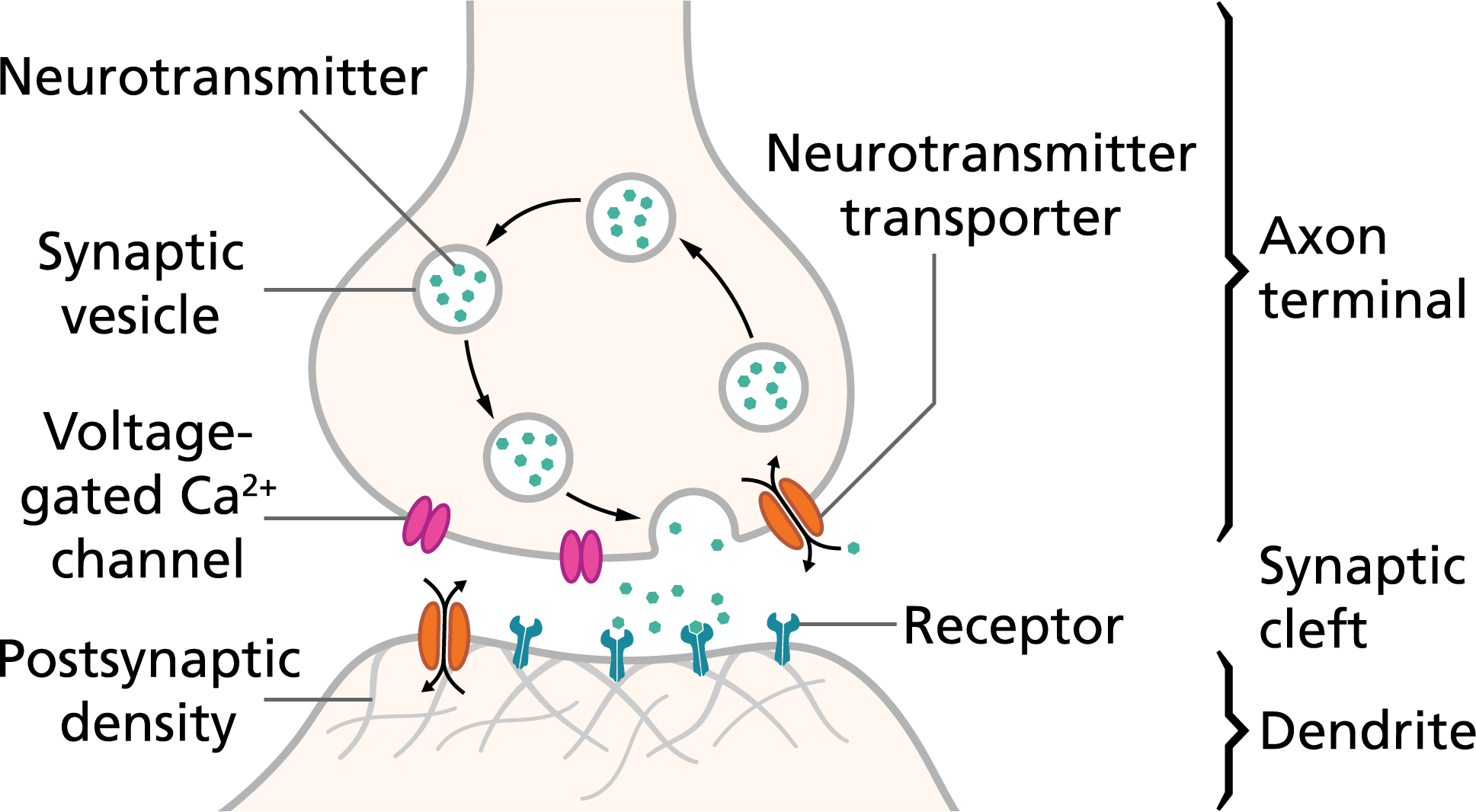Chemical Messenger Released at the End of a Nerve Cell
It also affects the contraction of smooth and cardiac muscle. Neurons form two types of nerves a sensory nerves which receive the information to convey to brain or spinal cord.

Action Potentials And Synapses Queensland Brain Institute University Of Queensland
It stimulates or inhibits another cell which can be a nerve cell muscle cell or gland cell.

. Middle layer of the three membranes meninges that surround the. Chemical messenger released at the end of a nerve cell. Acetylcholine norepinephrine dopamine and serotonin.
Examples are acetylcholine norepinephrine dopamine and serotonin. Neurotransmitter chemical released at the ends of nerve cells. Chemical messenger released at the end of a nerve cell.
Neurotransmitters are released at nerve terminals diffuse across the synapse and bind to receptors on the surface of the target cell often another neuron but also possibly a muscle or gland cell. Glial cell that forms the myelin sheath covering axons. It stimulates or inhibits another cell which can be a nerve call muscle cell or gland cell.
An explosion of electrical activity that is created by a depolarizing current 3. Carries impulses throughout the body. Part of the brain responsible for coordinating muscle movements and maintaining balance.
Chemical messenger released at the end of a nerve cell. Acetylcholine is a chemical messenger a neurotransmitter released by nerve cells in many parts of the peripheral nervous system. That starts a chemical reaction within the muscle.
Terms in this set 75 Acetylcholine. Parenchyma of the nervous system Neurotransmitter Chemical messenger released at the end of. It stimulates or inhibits another cell which can be a nerve cell muscle cell or gland cell.
Involuntary autonomic nerves that help regulate body. It controls the contraction of all skeletal or voluntary muscles for instance. Chemical messenger released at the end of a nerve cell.
Each receptor has a distinctly shaped region that selectively recognizes a particular chemical messenger. The messages are carried by chemical messenger across the neurons synapses. Myelin speeds impulse conduction along axons.
The chemical message a neurotransmitter called acetylcholine binds to receptors on the outside of the muscle fiber. Tap card to see definition. Neurotransmitter chemical released at the ends of nerve cells.
Tap card to see definition. Neurotransmitters are released at the end of the neural fiber ie. Acetylcholine ace-tyl-cho-line Click card to see definition.
Carries messages toward the brain and spinal cord. Click again to see term. Chemical messenger released at the end of a nerve cell.
The chemical messenger released at the end of a nerve cell that stimulates or inhibits another cell. Axon through the terminal buttons in the neurosecretory cells. Tap again to see term.
Nerve cell that carries impulses throughout body. When the nervous system signal reaches the neuromuscular junction a chemical message is released by the motor neuron. It stimulates or inhibits another cell which can be a nerve cell muscle cell or gland cell.
When an impulse arrives at the knob of the motor neuron calcium. The chemical messengers released at the end of axon terminal buttons by the arrival of nerve impulse and allowing nerve impulse to pass to another neuron are called neurotransmitters. Chemical messenger released at the end of a nerve cell it stimulates or inhibits another cell which can be a nerve cell muscle cell or gland cell.
Moreover the synaptic vesicles at the terminus of the pre-synaptic neuron store neurotransmitters. The nervous system controls the various functions by the units called neurons. Glial cell that forms the myelin sheath covering axons.
Click card to see definition. It is actually an enzyme which is released from one end of the synapse and which triggers the electrical message to. Name the correct term of.
An organic chemical that functions in the brain and body of many types of animals as a neurotransmittera chemical messenger released by nerve cells to send signals to other cells such as neurons muscle cells and gland cells 2. A neurotransmitter is a chemical substance that is released at the end of a nerve fiber by the arrival of a nerve impulse and by diffusing across the synapse or junction causes the transfer of the impulse to another nerve fiber a muscle fiber or some other structure. The presynaptic terminal is separated from the neuron or muscle or gland cell onto neurotransmitter also called chemical transmitter or chemical messenger any of a group of chemical agents released by neurons nerve cells to stimulate neighbouring neurons or muscle or gland cells thus allowing impulses to be passed from one cell to the next throughout the.
Space through which a nervous impulse travels between nerve cell or between nerve and muscle or glandular cells. These receptors act as on-and-off switches for the next cell. A neurotransmitter is a chemical messenger released by the end of a stimulated pre-synaptic neuron in order to transmit the nerve impulse through the synaptic cleft to the post-synaptic neuron or to an effector cell.
Hormones are chemical messangers secreted by endocrine ductless glands. Hormones are directly poured into blood.

What Are Chemical Messengers That Transport Nerve Impulses From One Nerve Cell To Another Called Study Com
4 1 The Neuron Is The Building Block Of The Nervous System Introduction To Psychology 1st Canadian Edition

Comments
Post a Comment